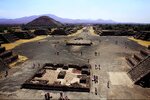1) The stepped pyramid was used for human sacrifice.
階段状ピラミッドは人身御供に使われた。
For example: the offering table that Artemis focused on when Laura traveled to Mexico.
例えば:ローラがメキシコ旅行に行った際にアルテミスが注目している供儀台

Source>
Ark & Laura Go to Mexico by Laura Knight-Jadczyk
Sacrific(e)...in Chichen Itza of Mayan civilization ruin, Mexico(950225)
「メキシコのマヤ文明の遺跡チチェン・イッツァ(では)生贄が捧げられた」(950225)

2) Yonaguni island seabed ruins in Japan are stepped pyramids.
日本の与那国海底遺跡は階段状ピラミッドである。
3) Even in Japan, there were at least some human sacrifice ceremonies.
日本でも人身御供ぐらい行われていたよ。
Reference: Examples of human sacrifice in Japan
参考:日本で行われていた人身御供の例
Hitobashira
From Wikipedia, the free encyclopedia
Hitobashira (人柱, "human pillar"), also known as daa saang zong/da sheng zhuang (Chinese: 打生樁; Cantonese/Mandarin romanisation) in China, myosade (မြို့စတေး) in Burma, and tumbal proyek in Indonesia, is a cultural practice of human sacrifice in East and Southeast Asia of premature burial before the construction of buildings. Hitobashira was practised formerly in Japan as a form of human sacrifice. A person was buried alive under or near large-scale buildings like dams, bridges and castles, as a prayer to Shinto gods. It was believed this would protect the building from being destroyed by natural disasters such as floods or by enemy attacks. Hitobashira can also refer to workers who were buried alive under inhumane conditions.
ヒトバシラ
フリー百科事典『ウィキペディア(Wikipedia)』より引用
人柱(ひとばしら、英語: Human Pillar)とは、中国語では大桑宗(ダーシャンチュワン、英語: Da sheng zhuang)とも呼ばれ、中国語では打生怙(ダーシャンチュワン、英語: Myosade)とも呼ばれる。中国では打生樁(広東語/北京語ローマ字)、ビルマではミオサデ(မြိ)、インドネシアではタンバルプロエクと呼ばれ、東・東南アジアで建物の建設前に早々と埋葬する人間の犠牲の文化慣習である。人柱は、かつて日本で行われていた人身御供の一種である。ダムや橋、城など大規模な建造物の下や近くに生きたまま埋葬し、神道の神々に祈った。水害などの自然災害や敵の攻撃から建物を守るためと信じられていた。また、人柱は、非人道的な条件で生き埋めにされた労働者を指すこともある。









